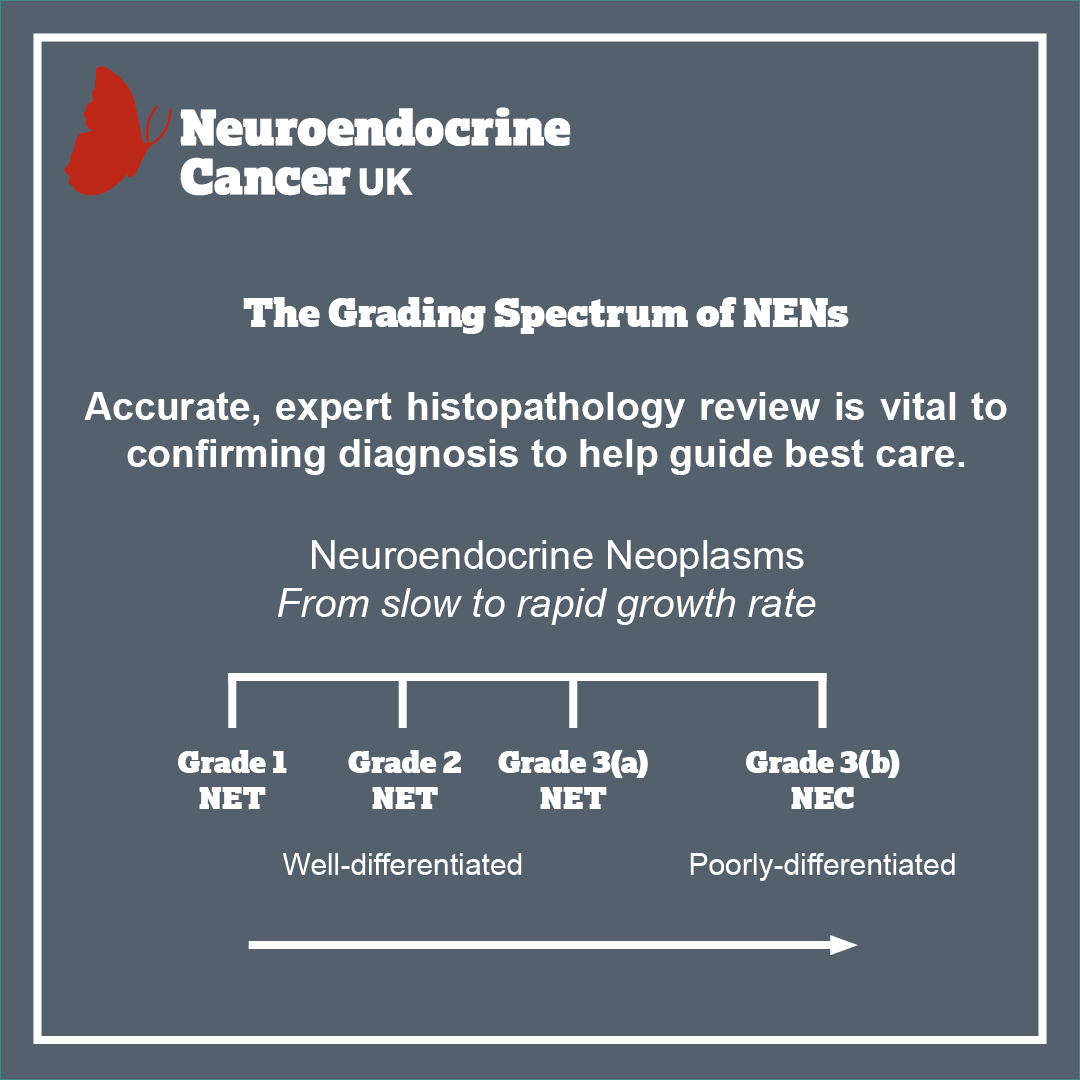NEUROENDOCRINE CANCER
CANCER OF THE UNKNOWN PRIMARY
The Facts
Neuroendocrine Neoplasm (NENs) is an umbrella term used to cover a group of cancers that start in neuroendocrine cells. These cancers may also be referred to as NETs, NECs, or even Carcinoids. NENs occur when neuroendocrine cells stop working normally and start to grow or behave abnormally.
There are 2 key types of NEN:
- NETs (neuroendocrine tumours) are called ‘well-differentiated’ and tend to have a slow to moderate growth pattern.
- NECs (neuroendocrine carcinomas) – are called ‘poorly differentiated’ and tend to grow rapidly.
To simplify, we use the term NENs throughout this page.
Cancer of the Unknown Primary
Cancer of the Unknown Primary (CUP) Although, it is usually possible to work out where a cancer has started by assessing symptoms and reviewing tests and scans, sometimes confirmation of the primary site is not always possible.
This may be due to the way NENs develop, they start at a size similar to a grain of sand and may take many months, possibly years to develop into the size that may be detectable by scans.
Despite the small size (sometimes simply a few cells) NENs may still spread to other organs (metastasise) – this does not necessarily indicate an aggressive nature, it may occur as a result of the cancer being present in your body for a long time. This means that the original collection of cells have been there so long, that over time, one or more cells may have had time to enter the blood of the lymph system and travel elsewhere in the body – most commonly the lymph nodes, liver, lungs or bone.
Your medical team may classify your cancer as being of unknown origin – or CUP (Cancer of Unknown Primary).
Symptoms
Symptoms that may or may not include Neuroendocrine Cancer associated syndromes (Syndrome is where 2 or more related symptoms occur).
Cancer of unknown primary may or may not produce symptoms, if they occur they will depend on the type and site of the primary.
They may, or may not, produce symptoms that are related to a Neuroendocrine associated syndrome (which may help in identifying the likely primary site).
Other, rarer symptoms, including Paraneoplastic syndrome and oncological emergencies, (a specific set of health concerns that can occur in any cancer), such as raised calcium levels (Hypercalcaemia), may occur.
Further information about Neuroendocrine Cancer associated and Paraneoplastic Syndromes – including Oncological emergencies – can be found here.
Tests
Tests that may be used for the diagnosis and / or monitoring of Neuroendocrine Cancer of Known Primary. Investigations should be guided by presentation – that is, clinical signs and symptoms – and need to include assessing all potential primary sites.
Pancreas, lung, right hemi-colon and small intestine are the most frequently occurring primary sites for Neuroendocrine Cancer. Carcinoid syndrome can be associated with distant metastases (especially where secondary spread is identified within the liver).
Blood and / or urine:
Full blood count
Liver and kidney function
B12/Iron/Ferritin/Folate
Chromogranin A
Gut Hormone profile
Calcium
Thyroid function tests
Urinary or serum 5HiAA (serotonin).
CEA, Beta-HCG, Alpha-FP, LDH, PSA, Ca19-9, Ca-125
Scans:
CT chest, abdomen and pelvis and/ or CT chest & MRI abdomen and pelvis
Octreotide (SPECT) or Gallium-Dotatate PET/CT
FDG-PET
Bone scintigraphy – if bone disease is present +/- suspected
Endoscopy:
As guided by clinical presentation / biomarker result
Pathology (what can be seen through special tests under a microscope):
Differentiation and cellular morphology
Synaptophysin
Chromogranin
Ki67
Additional IHC as clinically indicated

Grading
Not all cancers are the same or behave in the same way. Some may grow very slowly, may not have invaded nearby structures, or spread to other parts of the body at the time of diagnosis – but they have the potential to. However some may have already spread at the time of diagnosis. The grade is the rate at which the NEN grows. You might see this referred to as ‘Ki67’ or ‘Mitotic Index’ mentioned in your clinic letters or medical reports. Grade 1 is slow-growing through to Grade 3, a more aggressive, rapidly growing disease.


Causes and / or risk factors
We do not know exactly what causes NENs, however research is ongoing, to truly understand both the pathology and the biology with the hope that this will lead to a much better understanding of the causes. Most NENs do not run in families; however, there are a number of rare conditions that may increase your risk. Therefore, if other members of the family have been diagnosed with a particular cancer (especially aged 50 years or less) or cancer-associated genetic condition, it is important that you tell your specialist team about not only your medical history, but also any family medical illnesses or conditions.
So how is it treated?
For all patients, there are many things to consider in planning treatments. Your treatment will be personalised to you and the type of NEN you have. Even if you have a diagnosis that sounds the same as another patient, your treatment and follow up plan may be different.
Your care team will discuss your treatment options with you – giving you both written and verbal information – to help you make an informed choice. Together you can agree on the most appropriate treatment for you. There is consensus agreement that all NEN patients should be reviewed by a specialist MDT.
Treatment options will depend on the type, position and size of your NEN, and whether (or to where) it has spread. It will also depend on whether you have any other health concerns and / or illnesses and your general health and fitness. A big part of meeting with your doctors or specialist nurse/ team, is to make sure you get the information you need to understand your condition.


Follow up
There are expert agreed guidelines regarding how and when follow up should occur, however, in practice this varies and often with good reason – follow up should be expert informed & evidence /research based but also tailored to you and what is appropriate for your best care.
Follow up as per histology, grading and staging of disease – guided by results as per probable primary site.
Frequency as per disease status and potential for treatment.
Advanced disease:
Follow up as per guidelines – but should be guided by prognosis, expected treatment efficacy and treatment related toxicity. Your health, well-being, physical activity, informed choice and preference for ongoing care as well as aim of treatment should be reviewed and discussed to best plan care.
